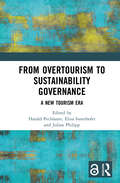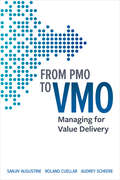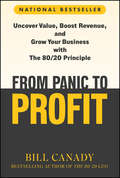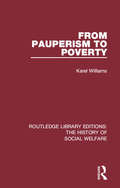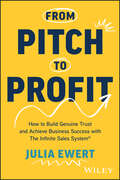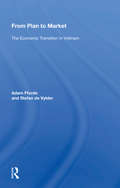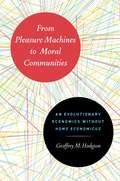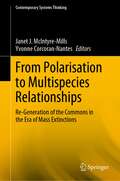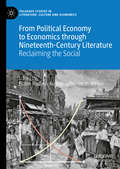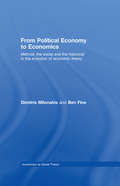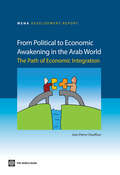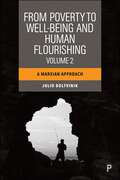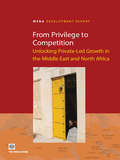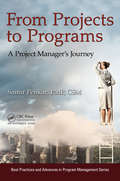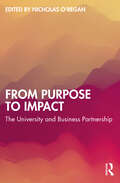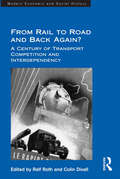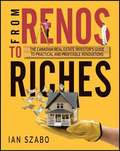- Table View
- List View
From Overtourism to Sustainability Governance: A New Tourism Era
by Elisa Innerhofer Harald Pechlaner Julian PhilippInsightful and international in scope, this significant volume explores the transition from overtourism to sustainability governance and elaborates perspectives for developing resilient destinations.The book is split into three parts and comprises interdisciplinary contributions from renowned authors and scholars in the field, with each part including case studies to illustrate real-world applications of the topics and issues discussed. Part I provides an overview of current academic discussion on overtourism, presents theoretical concepts and illustrates the impact of the COVID-19 pandemic, as well as the development from overtourism to no-tourism. Part II discusses approaches towards a new sustainability through the lens of current research and future trends, including a possible new understanding of tourism in a post-pandemic world. Part III presents strategies to deal with overtourism, including management strategies and governance theories. Equipped with a wide range of examples and insights from across the globe, the book is intended to facilitate the ongoing journey towards a more sustainable tourism industry, that is increasingly resilient and less vulnerable to crises.This will be of pivotal interest to academics, researchers and practitioners in the fields of tourism, over- and mass-tourism, as well as sustainability governance.The Open Access version of this book, available at http://www.taylorfrancis.com, has been made available under a Creative Commons [Attribution-Non Commercial-No Derivatives (CC-BY-NC-ND)] 4.0 license.
From PMO to VMO: Managing for Value Delivery
by Sanjiv Augustine Roland Cuellar Audrey Scheere"By the end of this book, you will understand what is valuable, how to measure value, and how to optimize the flow of valuefrom idea to your customer." Evan Leybourn, co-founder and CEO, Business Agility Institute Agile methods have brought about dramatic changes in how organizations manage and deliver not only IT services, but their entire product and service value streams. As legacy organizations transition to newer, end-to-end agile operating models, the Project Management Office (PMO) needs to redesign its mission and operation to be more in line with these modern ways of working. That requires being more customer-focused and value-adding, and less hidebound, bureaucratic and tied to antiquated processes and mindsets. Visionary leaders are transitioning into enablers of this change, and maximizing value through the entire organization. Middle management, including program and project managers (PMs), are racing to maximize their professional relevancy in this new world. This book defines the role of the agile value management office (VMO), using case studies and a clear road map to help PMs visualize and implement a new path where middle management and the VMO are valued leaders in the age of business agility.
From Panic to Profit: Uncover Value, Boost Revenue, and Grow Your Business with the 80/20 Principle
by Bill CanadyStructured corporate strategy to launch ambitious and consistent growth in just 100 days Armed with the hands-on guidance in From Panic to Profit: Uncover Value, Boost Revenue, and Grow Your Business with the 80/20 Principle, companies of any size and in any industry can pivot from panic to profit in a 100-day turnaround using just four steps: set the goal, develop the strategy, build the structure, and launch the action plan. To set the stage for the four steps, this book first empowers leaders to replace their fear, uncertainty, and doubt with confidence from segment-by-segment insights into their business, its customers, its products, and its markets. Written by Bill Canady, seasoned CEO with more than 30 years of experience as a global business executive, this book explores key concepts including: Unlocking the power of the 80/20 principle to boost company revenue, reduce costs, and accelerate profits Creating a business plan designed for continuous monitoring and improvement over a three- to five-year growth program Growing both organically and through strategic acquisition, developing the talent, expertise, and innovation needed to win in today's increasingly dynamic markets From Panic to Profit: Increase Revenue, Uncover Value, Boost Revenue, and Grow Your Business with the 80/20 Principle lays out an essential blueprint for all entrepreneurs, executives, managers, and business leaders seeking the confidence and tools they need to help their organizations reach great heights.
From Pauperism to Poverty (Routledge Library Editions: The History of Social Welfare #24)
by Karel WilliamsFirst published in 1981, From Pauperism to Poverty consists of seven essays, three of which focus on the English poor law between 1800 and 1914 and four of which examine texts of social investigation by Mayhew, Engels, Booth and Rowntree. Rather than making a specialist contribution to the history of social thought and policy, the essays raise general questions about current ways of writing history and alternative analyses of specific texts or institutions are developed. In doing so, the previous histories of the relief of pauperism and the discovery of poverty are revised at many points. Most notably, it is demonstrated for the first time that relief to unemployed men was virtually abolished after 1850. This book will be of interest to those studying the history of social welfare and poverty.
From Perception to Imagination: How Iconoclasts Free Themselves from Conventional Thinking
by Gregory BernsHumans depend on vision, more than any other sense to navigate through the world. Most of the time, the efficiency of our visual systems works to our advantage. Automatic processes, however, also get in the way of seeing things differently. Automatic thinking destroys the creative process that forms the foundation of iconoclastic thinking. This chapter takes a close look at the ways in which iconoclasts break down the brain's categorization processes and shows why to think like an iconoclast, you need novel experiences.
From PharmD to Industry: A Fellowship Guide (SpringerBriefs in Pharmaceutical Science & Drug Development)
by Victoria Langas Victoria FloodFor many Doctor of Pharmacy (PharmD) candidates, post-graduate training is a highly prestigious and sought after experience that can further one’s pre-existing education. Some of these post-graduate training opportunities include but are not limited to pharmacy residencies, pharmaceutical industry fellowships, and PhD/Masters programs. There is a large gap in the current Doctor of Pharmacy curriculum about pharmaceutical industry fellowship programs and potential pharmaceutical industry opportunities. Through the eyes of current industry fellows and professionals, this book serves as a resource to learn more about fellowship opportunities and their respective application processes. In addition, this manual aims to provide a clear and concise roadmap to achieving a career in industry through a fellowship program. Whether you are a current student pharmacist, post-graduate pharmacy trainee (pharmacy resident), or industry professional, this manual addresses the current landscape of industry fellowship programs, an overview of industry opportunities, and a glimpse into what being a fellow entails. Readers of this book can expect to gain: An overview of pharmaceutical industry fellowship programs and opportunities Helpful advice and insight from current fellows and industry professionals A streamlined pathway to navigating the fellowship application processAn understanding of the journey from being a student, to achieving a fellowship, to becoming an industry professionalThis book bridges the gap in education surrounding pharmaceutical industry fellowships and pharmacy careers in industry and increases access to first-hand information and real-world perspectives of current professionals to provide a firm foundation for those interested in pursuing a career in industry or learning more about fellowship programs.
From Pitch to Profit: How to Build Genuine Trust and Achieve Business Success with The Infinite Sales System
by Julia EwertLearn a proven, easy-to-follow, and repeatable approach for connecting with clients, winning negotiations, and increasing revenue — no matter your industry From Pitch to Profit reveals how you can win more clients and grow your business using The Infinite Sales System®: a strategic, tried-and-tested process that follows the same expert techniques used by the world’s best negotiators. Successful business is not about an aggressive used-car-sales approach. It’s about one-on-one communications that lead to trust and partnership. From Pitch to Profit gives you the strategies and easy-to-learn skills you need to build the genuine relationships that lead to higher sales and revenue. What does selling have in common with negotiating a hostage situation? How do you stand out amongst the competition? How do you sell effectively while staying true to yourself? How do you follow up, and when do you play the long game? From Pitch to Profit answers these questions and more, taking you step by step through how you can drive more business, consistently and efficiently. You’ll learn the conversations you need to connect with prospective clients and grow your profits — from a stellar first impression to building real, mutual trust. Discover the exact questions you need to ask in the first sales meeting — and get an actionable plan for following up more effectively. Learn how to spot the clues that will tell you what clients need from you to buy in. Successfully convert more match-fit customers. Generate more predictable revenue with higher margins. From Pitch to Profit gives you a proven, scalable process for selling a product or service, managing your clients, and successfully developing your business into a sustainable revenue machine.
From Plan To Market: The Economic Transition In Vietnam
by Adam FfordeThis clear and accessible text explores Vietnam's successful transition from neo-Stalinist central planning to a market economy—\"Vietnamese style.\" After describing the north Vietnamese system prior to 1975 and its colonial and precolonial antecedents, the authors uncover the mechanisms of that changeover. They contend that the Vietnamese transition was largely bottom-up in character and that it evolved over a long enough period for the country's political economy to adjust. This explains in part the rapid shift to a high-growth, externally oriented development path in the early 1990s, despite the loss of Soviet aid and the lack of significant Western substitutes until 1992-1993. Based upon extensive incountry experience, a wealth of primary materials, and wide comparative knowledge of development issues, the book challenges many preconceived notions, both about Vietnam and about the general nature of transition processes.
From Plant To Blue Jeans (Changes)
by Arthur L'HommedieuThis series details the astounding transformations that raw materials undergo as they are manufactured into goods that every child knows and uses. See raw metal ore become a horn, milk become ice cream, and more.
From Pleasure Machines to Moral Communities: An Evolutionary Economics without Homo economicus
by Geoffrey M. HodgsonAre humans at their core seekers of their own pleasure or cooperative members of society? Paradoxically, they are both. Pleasure-seeking can take place only within the context of what works within a defined community, and central to any community are the evolved codes and principles guiding appropriate behavior, or morality. The complex interaction of morality and self-interest is at the heart of Geoffrey M. Hodgson's approach to evolutionary economics, which is designed to bring about a better understanding of human behavior. In From Pleasure Machines to Moral Communities, Hodgson casts a critical eye on neoclassical individualism, its foundations and flaws, and turns to recent insights from research on the evolutionary bases of human behavior. He focuses his attention on the evolution of morality, its meaning, why it came about, and how it influences human attitudes and behavior. This more nuanced understanding sets the stage for a fascinating investigation of its implications on a range of pressing issues drawn from diverse environments, including the business world and crucial policy realms like health care and ecology. This book provides a valuable complement to Hodgson's earlier work with Thorbjorn Knudsen on evolutionary economics in Darwin's Conjecture, extending the evolutionary outlook to include moral and policy-related issues.
From Polarisation to Multispecies Relationships: Re-Generation of the Commons in the Era of Mass Extinctions (Contemporary Systems Thinking)
by Yvonne Corcoran-Nantes Janet J. McIntyre-MillsThis book explores the concept of multi-species relationships and suggests critical systemic pathways to protect shared habitats. This book discusses how the eradication of species as a result of rapid urbanisation places humanity at risk. This book demonstrates how narrow anthropocentrism has focused on the rights of human beings at the expense of other species and the environment. This book explores a priori norms and a posteriori measures and indicators to include and protect multiple species. This book aims to strengthen institutional capacity and powers to address and extend the UN 2030 Sustainable Development Agenda by drawing on local wisdom but also the need to implement laws to prevent ecocide. This book highlights that our fragile interdependence requires a recognition of our hybridity and interconnectedness within the web of life and suggests ways to reframe policy within and beyond the nation state to support living systems of which we are a strand.
From Political Economy to Economics through Nineteenth-Century Literature: Reclaiming the Social (Palgrave Studies in Literature, Culture and Economics)
by Elaine Hadley Sarah Winter Audrey JaffeFocusing on the transition from political economy to economics, this volume seeks to restore social content to economic abstractions through readings of nineteenth-century British and American literature. The essays gathered here, by new as well as established scholars of literature and economics, link important nineteenth-century texts and histories with present-day issues such as exploitation, income inequality, globalization, energy consumption, property ownership and rent, human capital, corporate power, and environmental degradation. Organized according to key concepts for future research, the collection has a clear interdisciplinary, humanities approach and international reach. These diverse essays will interest students and scholars in literature, history, political science, economics, sociology, law, and cultural studies, in addition to readers generally interested in the Victorian period.
From Political Economy to Economics: Method, the social and the historical in the evolution of economic theory (Economics as Social Theory)
by Ben Fine Dimitris MilonakisEconomics has become a monolithic science, variously described as formalistic and autistic with neoclassical orthodoxy reigning supreme. So argue Dimitris Milonakis and Ben Fine in this new major work of critical recollection. The authors show how economics was once rich, diverse, multidimensional and pluralistic, and unravel the processes that lead to orthodoxy’s current predicament. The book details how political economy became economics through the desocialisation and the dehistoricisation of the dismal science, accompanied by the separation of economics from the other social sciences, especially economic history and sociology. It is argued that recent attempts from within economics to address the social and the historical have failed to acknowledge long standing debates amongst economists, historians and other social scientists. This has resulted in an impoverished historical and social content within mainstream economics. The book ranges over the shifting role of the historical and the social in economic theory, the shifting boundaries between the economic and the non-economic, all within a methodological context. Schools of thought and individuals, that have been neglected or marginalised, are treated in full, including classical political economy and Marx, the German and British historical schools, American institutionalism, Weber and Schumpeter and their programme of Socialökonomik, and the Austrian school. At the same time, developments within the mainstream tradition from marginalism through Marshall and Keynes to general equilibrium theory are also scrutinised, and the clashes between the various camps from the famous Methodenstreit to the fierce debates of the 1930s and beyond brought to the fore. The prime rationale underpinning this account drawn from the past is to put the case for political economy back on the agenda. This is done by treating economics as a social science once again, rather than as a positive science, as has been the inclination since the time of Jevons and Walras. It involves transcending the boundaries of the social sciences, but in a particular way that is in exactly the opposite direction now being taken by "economics imperialism". Drawing on the rich traditions of the past, the reintroduction and full incorporation of the social and the historical into the main corpus of political economy will be possible in the future.
From Political to Economic Awakening in the Arab World
by Francisco H. G. Ferreira Julian Messina Jamele Rigolini Luis-Felipe López-Calva Maria Ana Lugo Renos VakisThe popular grievances that have fueled the Arab Spring since 2010 demonstrate that past development paradigms have failed to achieve the inclusive and sustainable growth expected by Arab populations. Countries in the Middle East and North Africa (MENA) region have failed to develop a strong private sector that is linked with global markets, survives without state assistance, and generates productive employment for young people. One key symptom of this maldevelopment is that, with the exception of the petroleum sector, MENA remains the least trade-integrated region in the world. The Deauville Partnership, launched by the Group of Eight (G8) in Deauville, France, in May 2011, is thus strategic and timely. At the request of the G8, this report provides an analytical framework for increasing trade and foreign direct investment (FDI) for Egypt, Jordan, Libya, Morocco, and Tunisia (the Partnership countries). Increased trade and FDI is a key means by which Partnership countries can achieve a path of sustainable growth that reduces youth unemployment. Moreover, trade and investment can also show short-term results. The G8 countries, Turkey, the Gulf states, and other Deauville partners can help the new Arab democracies achieve their objectives in two main ways: by effectively expanding market opportunities and by supporting domestic regulatory reforms. To start implementing a long-term vision of increased trade and investment integration, based on an integrated economic space in the Mediterranean basin, the Deauville Partnership could focus on five priority areas. These are helping Partnership countries adapt to a fast-changing trade, FDI, and jobs landscape; improving market access opportunities and market regulations; fostering competitiveness, diversification, and employment; facilitating trade and mobilizing trade finance and diaspora resources; and promoting inclusiveness, equity, and sustainability of the structural transformation brought about by the process of integration. The success of the Arab political awakening will greatly depend on the emergence of such an economic awakening that can generate quality employment for the millions of young Arab men and women who seek jobs and a decent life.
From Pompeii
by Ingrid D. RowlandWhen Vesuvius erupted in 79 CE, the force of the explosion blew the top right off the mountain, burying nearby Pompeii in a shower of volcanic ash. Ironically, the calamity that proved so lethal for Pompeii's inhabitants preserved the city for centuries, leaving behind a snapshot of Roman daily life that has captured the imagination of generations. The experience of Pompeii always reflects a particular time and sensibility, says Ingrid Rowland. From Pompeii: The Afterlife of a Roman Town explores the fascinating variety of these different experiences, as described by the artists, writers, actors, and others who have toured the excavated site. The city's houses, temples, gardens--and traces of Vesuvius's human victims--have elicited responses ranging from awe to embarrassment, with shifting cultural tastes playing an important role. The erotic frescoes that appalled eighteenth-century viewers inspired Renoir to change the way he painted. For Freud, visiting Pompeii was as therapeutic as a session of psychoanalysis. Crown Prince Hirohito, arriving in the Bay of Naples by battleship, found Pompeii interesting, but Vesuvius, to his eyes, was just an ugly version of Mount Fuji. Rowland treats readers to the distinctive, often quirky responses of visitors ranging from Wolfgang Amadeus Mozart, Charles Dickens, and Mark Twain to Roberto Rossellini and Ingrid Bergman. Interwoven throughout a narrative lush with detail and insight is the thread of Rowland's own impressions of Pompeii, where she has returned many times since first visiting in 1962.
From Poverty to Well-Being and Human Flourishing (Volume 2): A Marxian Approach
by Julio BoltvinikFollowing the highly respected first volume, this book continues to provide a holistic view of Julio Boltvinik’s vast and important work on poverty conceptualisation and measurement. While the previous book introduced the author’s widely adopted Integrated Poverty Measurement Method (IPMM), this new volume outlines his Marxian approach to poverty and human flourishing, focusing on what he conceptualises as human poverty. Bringing together 20 years of research, this interdisciplinary book provides an alternative to Sen’s Capability approach and details its internal consistency, solid foundations and promising perspectives for applicability.
From Preparatory Academy to National Flagship: The Evolution of Tsinghua University
by William C. Kirby Joycelyn W. EbyTsinghua University is one of the most prominent universities in China, and, increasingly, in the world. Its evolution to this position reflects the major developments in Chinese history--outward looking internationalism in the 1920s and 1930s, creative survival in the 1940s, Sovietization in the 1950s and 1960s, chaos in the 1970s, rebuilding in the 1980s, and, since the 1990s, a laser focus on becoming one of the best higher education institutions in the world. This case study traces this institutional history and then examines Tsinghua University's recent attempts at reform in faculty governance, curriculum, and funding as it seeks "world-class" status.
From Preparatory Academy to National Flagship: The Evolution of Tsinghua University
by William C. Kirby Joycelyn W. EbyTsinghua University is one of the most prominent universities in China, and, increasingly, in the world. Its evolution to this position reflects the major developments in Chinese history--outward looking internationalism in the 1920s and 1930s, creative survival in the 1940s, Sovietization in the 1950s and 1960s, chaos in the 1970s, rebuilding in the 1980s, and, since the 1990s, a laser focus on becoming one of the best higher education institutions in the world. This case study traces this institutional history and then examines Tsinghua University's recent attempts at reform in faculty governance, curriculum, and funding as it seeks "world-class" status.
From Privilege to Competition: Unlocking Private-led Growth in the Middle East and North Africa
by World Bank'From Privilege to Competition: Unlocking Private-Led Growth in the Middle East and North Africa' sheds new light on the difficult quest for stronger and more diversified growth in a region of unquestionable potential. It underlines the need to strengthen reforms in many areas-specifically, by reducing policy uncertainty and improving credit and real estate markets. It also highlights other important issues that restrain the credibility and impact of reforms in many parts of the region: conflicts of interest between politicians and businesses, an investment climate that favors a few privileged firms, and a dominant private sector that often opposes reforms. The book recommends that countries in the Middle East and North Africa (MENA) engage in more credible reform agendas by improving the implementation of policies in a manner that will reduce discretion and privileges. This renewed commitment to stronger growth would entail several developments. First, governments will need to reduce opportunities for rent-seeking and foster competition. Second, they will need to work to reform institutions: private sector development policies will need to be systematically anchored in elements of institutional and public sector reforms in order to reduce discretion and opacity and improve the quality of services to firms. Third, they will need to mobilize all stakeholders, including larger representations from the private sector, around dedicated long-term growth strategies. Short of such a fundamental shift in the way private sector policies are formulated and implemented, investor expectations that governments are committed to reform will be limited. It will take political will-and time-to support sustained reforms that credibly convince investors and the public that changes are real, deep, and set to last. MENA countries are endowed with strong human capital, good infrastructure, immense resources, and a great deal of untapped creativity and entrepreneurship. The economic and social payoff of embarking on a more ambitious private-led growth agenda could thus be immense-for all.
From Projects to Programs: A Project Manager's Journey (Best Practices in Portfolio, Program, and Project Management #8)
by Samir PenkarThis book tells the story of an up-and-coming project manager that's been handed a large program to lead. Readers follow along as she struggles, leads, stumbles, and grows into the program manager role. Introducing key program management concepts throughout, the book provides a backstage view into the workings of program management, program organization, team dynamics, and the skills required to manage programs. Told through the eyes of a program manager, readers will experience the ins and outs of program management.
From Purpose to Impact: The University and Business Partnership
by Nicholas O’ReganTo meet the challenge of closing the gap between academic research and industry practice, we need a step change in how the business school and the business scholar engages with business. This book presents best practice in the methods of broadening successful academic–business engagement on a major scale. It presents concrete recommendations for setting programmes, creating incentives and structuring recruitment that will transform effective academic–business engagement.Most universities claim to have significant links with industry and the professions, but, in reality, only a limited number of business scholars are engaged with industry. A focus on ‘impact’ presents an additional potential trap, confusing promotion of research and tactical tips and tricks, with genuine engagement. This book explores the increasing number of new and innovative partnerships and collaborative activities, and looks at how academics can adapt to and leverage these new opportunities. It focuses on the academic as the primary driver of the external relationship and outlines the skills and capabilities needed to proactively develop engagement. Finally, the book provides a number of examples of best practice from a range of countries.Written by senior business scholars and leaders from around the world, and with examples of best practice included from leading universities, this book gives universities the insight needed to develop a broader range of relationships with businesses and to have genuine engagement and impact in practice.
From Rags to Riches: People Who Started Businesses from Scratch
by Nathan AasengPresents brief biographies of the enterprising individuals who started such companies as HP, Apple computers, Sears, The Wall Street Journal, J.C. Penney, Hershey's chocolate, Marriott and Procter & Gamble.
From Rail to Road and Back Again?: A Century of Transport Competition and Interdependency (Modern Economic And Social History Ser.)
by Colin DivallThe coming of the railways signalled the transformation of European society, allowing the quick and cheap mass transportation of people and goods on a previously unimaginable scale. By the early decades of the twentieth century, however, the domination of rail transport was threatened by increased motorised road transport which would quickly surpass and eclipse the trains, only itself to be challenged in the twenty-first century by a renewal of interest in railways. Yet, as the studies in this volume make clear, to view the relationship between road and rail as a simple competition between two rival forms of transportation, is a mistake. Rail transport did not vanish in the twentieth century any more than road transport vanished in the nineteenth with the appearance of the railways. Instead a mutual interdependence has always existed, balancing the strengths and weaknesses of each system. It is that interdependence that forms the major theme of this collection. Divided into two main sections, the first part of the book offers a series of chapters examining how railway companies reacted to increasing competition from road transport, and exploring the degree to which railways depended on road transportation at different times and places. Part two focuses on road mobility, interpreting it as the innovative success story of the twentieth century. Taken together, these essays provide a fascinating reappraisal of the complex and shifting nature of European transportation over the last one hundred years.
From Recognition to Support: Gaining a Foothold--Moving Innovation from Idea to Reality
by Harvard Business Review PressRecognizing an idea's potential is an important step in the innovation process. But getting the right people to recognize the idea--that is, people with the power to allocate resources--is another hurdle, and one that demands substantial organizational skill and entrepreneurial drive. This chapter identifies practical steps the entrepreneur/innovator can take to move beyond initial recognition to a situation involving greater support. It covers the critical role of the idea champion and other supporters, the importance of timing in gaining recognition and support, and how to build a business case for an innovative idea and overcome resistance. This chapter was originally published as chapter 4 of "Harvard Business Essentials: The Innovator's Toolkit."
From Renos to Riches
by Ian SzaboFROM RENOS TO RICHESTHE CANADIAN REAL ESTATE INVESTOR'S GUIDE TO PRACTICAL AND PROFITABLE RENOVATIONSAs an investor, part of providing a residence for your tenants is providing a place where they will feel at home and want to stay. How do you do this affordably and strategically? Many landlords will either do a minimal amount of work-and work that has no lasting value-or at the other end of the spectrum, go overboard, using expensive materials and paying for extra and unnecessary labor. Rental renovations are meant as a long-term investment with your best asset in mind-your tenant. Knowing what renovations to undertake and how to do them will guarantee that money is well spent on long-term renovations that last the life of the property and decrease tenant turn-over and loss of rental income.From Renos to Riches is the product of the author's experience as a renovator and investor in residential properties. It offers the reader insights into these key areas: how to assess and cost a renovation and determine if it makes financial sense; what's involved in contracting out a job; how to keep to budget and timelines; how to green your property; jobs you can tackle yourself; design tricks that are inexpensive but look like a million bucks; and much more. With this book you can grow the value of your portfolio of properties; increase cash flow through strategic renovations and decrease expenses by saving money on maintenance by doing the job right the first time; reduce energy usage; and create goodwill with the people who drive your business-your tenants.
